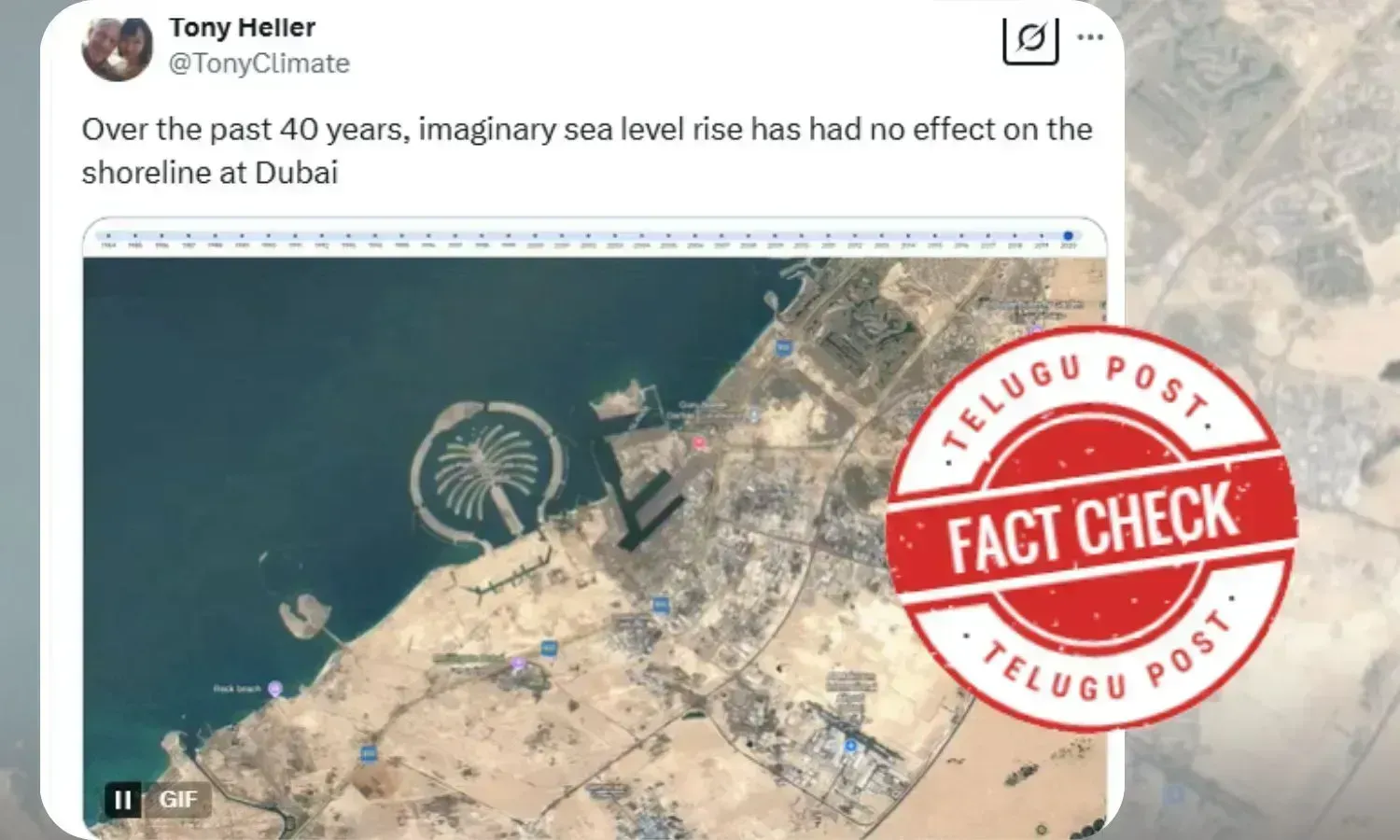Fact Check: Why Dubai’s shoreline isn’t proof enough that sea levels aren’t rising?
A viral claim on X suggests that Dubai’s shoreline has remained unchanged over 40 years, implying that sea-level rise is imaginary. However, scientific data and climate studies confirm that sea levels are rising globally.

Claim :
Viral post falsely claims sea-level rise is imaginary, citing a time-lapse of Dubai’s unchanged shoreline as evidenceFact :
Dubai's shoreline appears unchanged due to proactive coastal management while global sea levels are rising due to glacier melt and ocean expansion
Climate change ‘naysayers’ may raise unreasonable doubts about the extent to which climate change is caused by humans, however, it is also a fact that human activities have contributed substantially to climate change through greenhouse gas emissions.
According to UNESCO, the planet earth has lost 9,000 gigatons of ice in regions such as the Arctic, the Alps, South America, and the Tibetan Plateau since 1975 and the rapid melting of glaciers is due to climate change.
It’s been widely accepted that 2024 was the single warmest year on record as it breached 1.5 degree Celsius warming threshold. The rise in greenhouse gas level is significantly contributing to the increase in global temperatures and due to this environmental concern, glaciers and sea ice continue to melt at an alarming rate which in turn pushes sea-levels to a new high.
Even as researchers are documenting the environmental concerns diligently, a user has posted on X claiming the ‘change in sea level’ is imaginary and he shared a GIF of Dubai’s shoreline capturing 40 years of data in a time-lapse video. He also added that if the
sea-level threat was real, it would have affected the contours of the coastal region of the desert city.
Claim on X: ‘Over the past 40 years, imaginary sea-level rise has had no effect on the shoreline at Dubai.’
The viral claim link is here and the archive link here.
Here’s the screenshot of the viral post.
Fact Check:
During the investigation, the Telugupost fact check team found the claim that ‘imaginary sea-level rise has had no effect on the shoreline at Dubai" is misleading. Notably, Dubai is taking proactive steps to reduce the impact of climate change on its sea line with the addition of mangroves.
Understanding rise in sea levels
Sea-level rise refers to the increase in the height of the ocean’s surface, which affects coastlines around the world. Measuring this change is crucial for understanding the rate and effects of rising seas on both global and local scales. Scientists use two main tools to track sea level changes: tide gauges and satellites.
According to climate studies, the global mean sea-level is rising primarily due to global warming and this phenomenon is manifested in two ways. The global seas have witnessed a marked increase due to the continued melting of glaciers and ice sheets as it is adding water to the ocean. Secondly, the rise in global temperature is resulting in warm waters which is also helping the volume of the ocean to expand.
A study by NOAA (National Oceanic and Atmospheric Administration) stated that between 1993 and 2023 mean sea-level has risen across most of the world's oceans (blue colors). In some ocean basins, sea-level has risen 6-8 inches (15-20 centimeters).
On August 10, 1992, the scientists and engineers launched a new satellite TOPEX/Poseidon into space to study the rising and falling of seas over time.
Scientists have found that global mean sea-level—shown in the line plot above and below—has risen 10.1 centimeters (3.98 inches) since 1993. Over the past 140 years, satellites and tide gauges together show that global sea-level has risen 21 to 24 centimeters (8 to 9 inches).
Regional relative sea-level change
While measuring the regional relative sea-level change, the researchers take multiple physical processes into account. These processes including short term effects, sterodynamic variability, glaciers, land water storage, ice sheets and subsidence, vary both in space and time and can lead to large regional departures from the long-term rate of global mean sea-level rise.
According to a 2020 study on assessment of climate change impacts on sea surface temperature and sea-level rise - the Arabian Gulf, ‘most of the Arabian countries along the Gulf have coastal developments at low-land areas of high vulnerability to sea-level rise.’
When the researchers used machine learning and deep learning approach to predict sea-level rise at five critical locations along Dubai’s coastline by 2050, they found Al Jadaf, Dhaw Wharfage, and Umm Sugeim as high-risk areas. These results indicate an increase in sea-levels across all locations by 2030, with the Mamzar area experiencing the highest average annual increase. The assessment was made using the historical data (2004 to 2019).
Finding a specific 40-year study focused solely on sea-level rise impact on Dubai's shoreline excluding development and land reclamation is challenging.
Recently, the UAE government has decided to redefine the concept of coastal regeneration. Under the Dubai Mangroves project, over 100 million mangroves, a group of trees and shrubs that live mainly in coastal waters, would be planted along the stretch of more than 70 km on Dubai’s shoreline. Mangroves are nature’s own defense system against coastal erosion and rising sea-levels. The mangroves are enough to absorb over 1.2 million metric tons of CO2 per year.
The current lack of significant impact on the shoreline is more a result of Dubai's proactive coastal management rather than the absence of sea level rise. Hence, the claim that "imaginary sea-level rise has had no effect on the shoreline at Dubai" is misleading.

